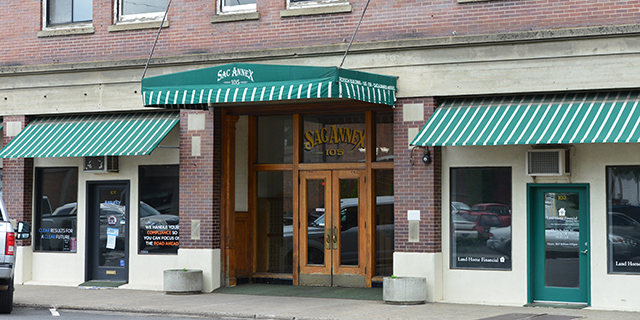Protecting, preserving moraines focus of forum
Published 4:27 pm Monday, October 6, 2008

- Ellen Bishop, second from left, discusses the characteristics of the moraines at Wallowa Lake for the Moraines of Wallowa Lake: Securing a Community Legacy Forum. This was one of several field trips included in the forum agenda. - Photos/RON OSTERLOH
JOSEPH – Everyone who visits Wallowa Lake, the jewel of Northeast Oregon, knows what a beautiful sight it is, sparkling in the sun of late summer as it rests between the protecting arms of the glacial lateral moraines on its east and west sides and the terminal moraine at its foot on the northern end.
What most people don’t realize is that this iconic landscape curving around the lake is almost all privately owned.
An interactive community forum titled “The Moraines of Wallowa Lake: Securing a Community Legacy,” conducted at the Joseph Community Center Sept. 27 by the Wallowa Land Trust, created an environment where landowners, the Nez Perce, county officials, an economist, a geologist, and a professor and students of environmental humanities participated in discussions about local efforts to protect and preserve the moraines.
Wallowa Resources, a local non-profit organization, the Nez Perce Tribe Department of Fisheries Resources Management, the Nature Conservancy and the Oregon Department of Fish and Wildlife collaborated on the forum.
Lowell Lewis, longtime Joseph resident and owner of the Circle P Ranch, 148 acres on the terminal moraine at the north end of the lake, said it was his desire to preserve the integrity of the moraine and he was willing to talk about establishing hiking trails to access the area.
“This land has been in the family 80 years. I want it preserved, not rezoned, but it’s gonna cost money and that’s where we’re at right now,” Lewis said.
Ted Hays has owned land, which borders the river and the dam on the northwest side of the lake, since the early 1960s.
“When we talk about the land, we talk about ourselves. My great-grandparents settled here, they loved this land, not just the moraine. It’s more than that. It’s a holy land for the Nez Perce.
“The water and land is precious,” he added. “We share land, have ceremonies with the native peoples. We all recognize the need for change in order to fully respect this land. I am very interested in preserving it. I believe in the essentialness of coming together to listen to each other,” he said.
RY Timber, owned by the Ron Yanke family of Boise,purchased more than 1,700 acres of the east moraine between 1990 and 1993, according to Property Manager Bruce Dunn of Enterprise.
“RY Timber and the Yanke family have tried to be good stewards of this land. We have cleaned up the degraded areas and restored the timber. We’ve allowed riding, hiking and other access to the land.”
Dunn added that in 2004 the Yanke Family Trust was formed for estate planning purposes. They agreed to work together with Wallowa County to sell development rights or establish conservation easements and are still working on those negotiations, according to Dunn.
County commissioner Dan DeBoie thanked the Yanke family for their patience in the negotiations and commented that there was a need for a permanent solution that involved sustainable community use and depending on the Land Use Plan may not produce the desired results in the necessary time frame.
Other land owners included Mark Lacey of Joseph, who owns 36 acres of forested land on the west side of the west moraine; Frank Kimball, who owns the only buildable lot with waterfront left on the west moraine; Chris Buhler, whose family owns a working cattle ranch to the west and north of the lake; Alistair Paterson, a recent arrival originally from Zambia, with 12 acres.
“We do our best to tread carefully on the land,” Paterson said. “We are drilling a well and are at 300 feet and no water yet. We feel we have something to offer the community and look forward to meeting with the Nez Perce about appropriate use of the land.”
The Nez Perce were represented by tribal elder and spiritual leader, Dr. Horace Axtell, and Joseph McCormack of Joseph.
In a moving and heartfelt statement, Axtell shared stories of his grandmother who was born in the Wallowa Valley. He said he was glad to see such a crowd of people who were gathered to talk about their concern for the land.
“I commend you all for being so trustful to do what you are doing for the land. This land was the most powerful spirituality of the Nez Perce tribe before the missionaries came. I speak from my heart because I’m proud of what you’re doing, I can see it in your faces that you care for this land,” he said.
McCormack reminded the gathering, “In the 1800s we were asked to sell this land and we agreed to do that but in that agreement we preserved certain connections to the land and the resources. The world is huge and there is not always a shared vision for a place like this; to join together to gain a level of protection for the Wallowa Lake Basin. Our wish is to perpetuate the scenery and the ecology here. I’m glad to see all of you here. Our hearts are open and we can get good things done.”
The forum agenda also included memories from Dave and Darlene Turner of Joseph, both of whom were present at the first Chief Joseph Days Rodeo held up on the east moraine in July 1946.
Donald Snow, senior lecturer of Environmental Humanities and General Studies at Whitman College in Walla Walla, urged the audience to consider the phenomena known as “Rurbia.” According to Snow, it is a sequence of events triggered when a small, rural, isolated, aesthetically appealing area is “discovered” by young, wealthy retirees, who have dreamed of building or buying the quaint, picturesque log house in the forest.
According to Snow, with the arrival of urban growth in the middle of nowhere, median home prices rise and other prices follow, driving up the cost of living for the middle to low income inhabitants of the town.
Another result of Rurbia is that the working landscapes can disappear since they are not necessary for the livelihood of those who now own the land.
The regional Extension economist from OSU, Bruce Sorte, responded to Snow’s presentation, saying that successful communities of the future will welcome outsiders and treat visitors as opportunities. They will encourage second-home owners to live locally year round by increasing the area amenities. A successful community will develop a unique feature and maintain their natural resource base, according to Sorte.
“You have about 4,000 square miles in Wallowa County and 7,200 people. You could easily accommodate 7,000 more,” he said.
The forum actually began the evening of Sept. 26 with two field trips, one led by geologist Ellen Morris Bishop up onto the terminal moraine at the north end of Wallowa Lake and the other, led by McCormack and Tim Nitz, toured the Marr Ranch land south of Joseph that was recently purchased by the state of Oregon and a coalition of three Indian tribes.
The field trips were repeated Sept. 28 along with additional hikes up on the east and west moraines of the lake.
The purpose of the hiking trips was to obtain firsthand knowledge about ecology, healthy forest management, geology, and culturally and historically significant sites.
Bishop pointed out the geologically unique qualities of the moraines and also the unsuitable nature of the moraines for residential development.
Participants in the trip on the west moraine learned about efforts by local citizens to ensure its protection.
Bureau of Land Management retiree Dick Burch of Joseph said that what the Wallowa Land Trust had accomplished with this community forum was remarkable.
“This couldn’t be done by public land agencies like the BLM because they have lost their credibility. Decisions are no longer made at the local level. Private agencies are famous for their collaboration with local partners.”
County Commissioner Mike Hayward closed the forum saying, “We pride ourselves on working collaboratively. This is a time to demonstrate that this is what we plan to do. This is a start. There will be more conversations and we can get it done. Collaboration is the key.”









